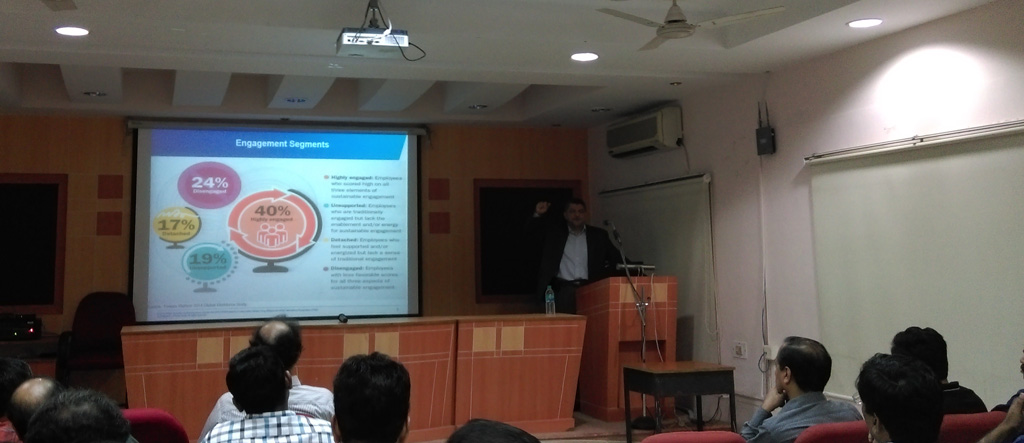SPIN Chennai had organized a talk on “Leveraging a structured framework for organizational development and talent management” by Mr.Sankaran Venkataramani (Technical Director KPMG, Lead Appraiser for CMMI-DEV) today. It was a great talk, Mr.Sankaran’s vast experience in this area was imminent right from word GO!. He shared lot of examples and anecdotes that made the listening lively and memorable.

Talent Management by Sankaran Venkataramani (KPMG)
His slide deck is available here, following are from my notes of the event:
Talent management is the science of using strategic human resource, everything done to recruit, retain, develop, reward and make people perform, forms a part of talent management.
- Sustainable engagement is to have people feeling engaged, energized & enabled
- In the modern GEN “Y” workplace, policies are to be made available now in mobile apps; updates have to be done every not in years but every month or everyday!
- Realize that today in workplace, multiple generations are working in the same organization at the same time
From a Global workforce survey done by Towers Watson 2014:
- Across age groups (in workforce) compensation (base pay) is the #1 driver for attraction and retention. But mere presence of a (high) compensation is not a motivation, but it’s absence is a big demotivation
- Biggest lever for motivation is not to have any secrecy in performance measurement
- Today, across age group, stress is a concern, work life balance is an important item
- The survey was done in 142 countries including India and they found only 40% highly engaged, 17% detached (not engaged), 19% unsupported (they don’t have energy), 24% disengaged
This is an interesting real life story, at one organization initially they brought in work from home policy. Every one was happy. Then they introduced a Crèche for others who had to come to office, so that they can leave their kids in safety and work. Now the organization has people who come, leave their kids in Crèche and then go back to home (to work from home). Because of work from home, we all work more hours, but are those hours more productive, that’s debatable. We keep oscillating between work and personal, so we are not sure on the hours we spend, we don’t get a satisfaction we worked, we feel guilty on both our work and our life.
Many organization’s leave their important asset (people) to be managed by “managers”. In most reviews the employees (nearly 80%) are evaluating their boss, not the other way around. All Companies have culture. It is not defined, not written, but felt, sensed. It is more wide spread and followed than policies written. People are more aware of culture than policies.
Many companies which are now rumoured to be mass sacking )are not hit by any sudden happenings) due to having poor foundation in people management – Poor tools to HR, empowerment being misused, too many relatives or close ones were recruited and so on. A joke going around in circles is “for many people work and home were same, they were seeing the same faces” :-). Too many times exit interviews have become induction program, only then employee knew what’s available in the company.
Today the less than 30 age group doesn’t want to work on ambiguity. But older age work are willing to. Whenever you ask a question (say a survey) to employees, it has an implicit guarantee, an expectation is raised. You should do employee satisfaction surveys only if you have the will to follow up on what it throws up, to do a survey and let it gather dust, removes all hope and causes damage.
PCMM maturity framework is a ruler which can support to draw a line. It is not the line by itself. There are five levels in PCMM.
- Behaviour analysis, some analysts have seen patterns to predict employee behaviour. For example the ill fated MH370 flight pilots before departure have been seen doing military salutes, which they have never done before. In many companies when you take an interview for a role (or promotion), they see whether in the last six months you have demonstrated the competency of the roll you are applying; it is not the role you currently do that’s evaluated
- Many consider the alternative to the disliked Bell curve to be “Power law distribution“, can it be?. In the bell curve, based on who (each employee) is where, you can predict your company performance for that upcoming year
- If your delivery guys are at level five (PCMM), then your sales also have to be at level five. Mismatch between departments will NOT led to organization success
- If people feel they are not aligned to organization goal, then people will feel unneeded. Most companies now want to adapt PCMM. It is certainly not about getting the rating (levels). Toyota in one of their path breaking studies, classified all organizations into three groups. Spiritual, Ritualistic and Materialistic
- In every organization, the HR head should be more worried about the company winning projects, more than the sales head. Without growth and sales, your asset (people) are sitting ducks with ready to use competencies for your competition


Excellent snap of the session ! Thanks Venkat !